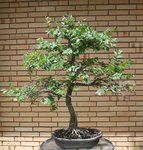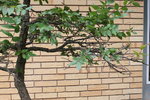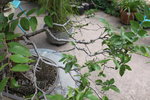Michael P
Omono
I originally posted this in Markscott's excellent new thread on defoliation. It was a bit of a hijack and never received a response, so I'll it a separate thread.
This year my cedar elm just began to leaf out and immediately developed a massive scale and mealy bug infestation on the lower third of the tree. I've never seen anything quite like it. I got it under control with a combination of physical removal, soapy water spray, and a systemic insecticide. The tree now appears pest-free.
The top two thirds of the tree are growing strongly, but the bottom third never fully recovered. No branches died, but all have very sparse foliage. I have been fertilizing and letting the tree grow freely to regain strength. But the top is dense and the lower branches are not catching up.
Should I let the tree continue to grow freely this year, or should I prune or partially defoliate the top to redirect energy to the lower branches? This tree is a collected specimen that I styled in a workshop with Nick Lenz, so I really don't want to lose it, damage it, or have to redesign it.
I'll post some photos later today.
This year my cedar elm just began to leaf out and immediately developed a massive scale and mealy bug infestation on the lower third of the tree. I've never seen anything quite like it. I got it under control with a combination of physical removal, soapy water spray, and a systemic insecticide. The tree now appears pest-free.
The top two thirds of the tree are growing strongly, but the bottom third never fully recovered. No branches died, but all have very sparse foliage. I have been fertilizing and letting the tree grow freely to regain strength. But the top is dense and the lower branches are not catching up.
Should I let the tree continue to grow freely this year, or should I prune or partially defoliate the top to redirect energy to the lower branches? This tree is a collected specimen that I styled in a workshop with Nick Lenz, so I really don't want to lose it, damage it, or have to redesign it.
I'll post some photos later today.






